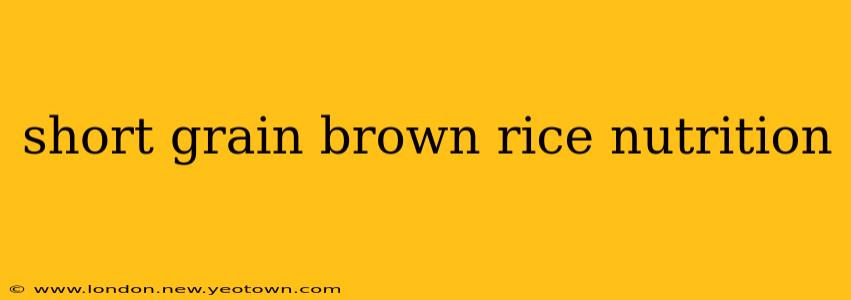Let's embark on a culinary journey to explore the nutritional wonders of short grain brown rice. Far from just a simple side dish, this humble grain packs a powerful punch of nutrients, making it a staple in healthy diets worldwide. Its unique texture, slightly chewy and sticky, sets it apart, making it perfect for sushi, rice pudding, and countless other dishes. But beyond its culinary versatility lies a treasure trove of health benefits.
What are the Nutritional Benefits of Short Grain Brown Rice?
Short grain brown rice boasts an impressive nutritional profile, significantly richer than its white rice counterpart. This is because the bran and germ layers – the most nutrient-dense parts of the grain – are retained during processing. This means you get a hearty dose of fiber, essential vitamins, and minerals. Think of it as nature's multivitamin, seamlessly integrated into a delicious and versatile food.
One serving (about 1/2 cup cooked) typically provides:
- Fiber: A significant source of both soluble and insoluble fiber, aiding digestion and promoting gut health. This fiber also contributes to feelings of fullness, helping with weight management.
- Magnesium: Crucial for muscle and nerve function, blood sugar control, and blood pressure regulation.
- Manganese: Important for bone health, wound healing, and metabolism.
- Selenium: An antioxidant that protects cells from damage.
- Phosphorus: Essential for bone health, energy production, and cell function.
- B Vitamins: A range of B vitamins, including thiamin, riboflavin, and niacin, crucial for energy production and nerve function.
Is Short Grain Brown Rice Better Than Long Grain Brown Rice?
This is a question often asked, and the answer is nuanced. Both short and long grain brown rice offer impressive nutritional value. However, the key difference lies in their texture and amylose content. Short grain rice has a higher amylopectin content, resulting in its sticky texture. This makes it ideal for dishes where stickiness is desired, while long grain rice, with its higher amylose content, remains fluffier. Nutritionally, the differences are minimal; the choice ultimately comes down to personal preference and intended use.
What are the Differences Between Brown Rice and White Rice?
The primary difference lies in the processing. Brown rice is minimally processed, retaining its bran and germ layers. This is where most of the fiber, vitamins, and minerals reside. White rice, on the other hand, undergoes extensive processing, removing the bran and germ, which significantly reduces its nutritional value. While white rice offers a smooth texture and quicker cooking time, brown rice shines in terms of nutritional density.
How Many Calories are in Short Grain Brown Rice?
A 1/2 cup serving of cooked short grain brown rice typically contains around 110-120 calories. However, calorie content can vary slightly depending on the brand and cooking method.
Is Short Grain Brown Rice Good for Weight Loss?
Due to its high fiber content, short grain brown rice can be beneficial for weight management. The fiber promotes satiety, helping you feel fuller for longer, potentially reducing overall calorie intake. However, like any food, moderation is key. Incorporating it as part of a balanced diet and regular exercise routine will contribute to effective weight loss.
How to Cook Short Grain Brown Rice Perfectly
Cooking short grain brown rice perfectly requires a little attention, but the result is worth the effort! The key is to use the right ratio of water to rice (typically 2:1) and to allow it to simmer gently until all the water is absorbed. Overcooking can result in mushiness, while undercooking leaves it hard and unpalatable. Experiment with different techniques – some prefer to rinse the rice before cooking, while others don't. Find what works best for you and enjoy the delicious outcome!
In conclusion, short grain brown rice is a nutritional gem, offering a wealth of health benefits and culinary versatility. Its sticky texture makes it a fantastic ingredient in a wide array of dishes, from savory to sweet. Incorporating this nutritious grain into your diet is a simple yet effective way to boost your overall health and well-being.

